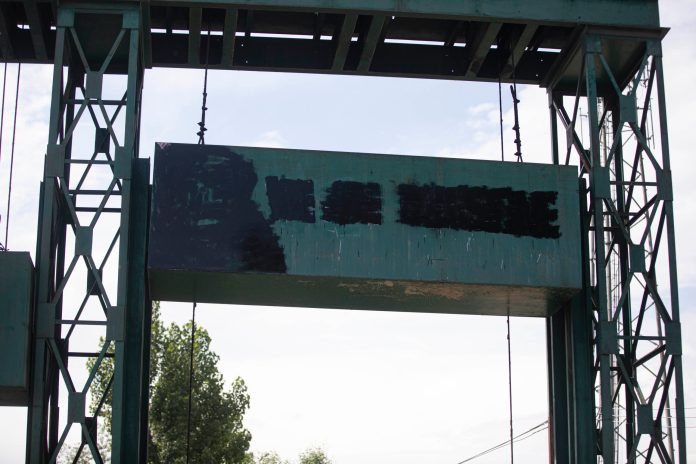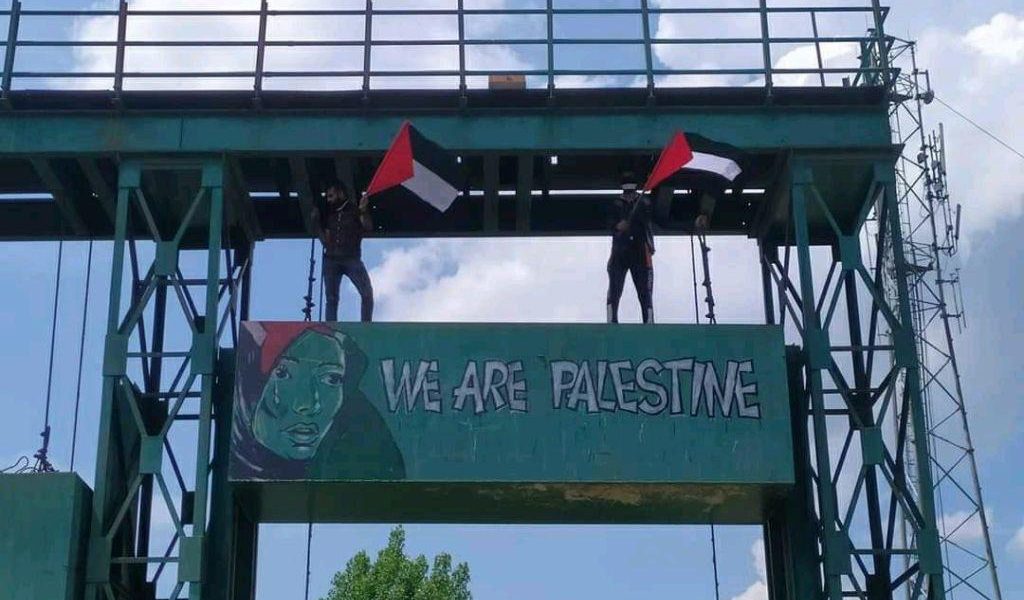“Art in times of revolution succinctly chronicles public opinion and perspectives. It gives voice to the mute and eyes to the blind by simply documenting the ongoing political crisis.” – writes Talha Mujibi in the Live Wire.
The Israeli military launched a series of air raids on the Gaza strip that have been sharply increasing over the past few weeks. At least 227 people, a substantial portion of which include children, have been killed in Gaza since the Israeli attacks began. Israeli military said the airstrikes were in retaliation for the Palestinian militant group Hamas firing rockets into Israel, but experts have pointed out that the escalation was a result of Tel Aviv’s own actions in Sheikh Jarrah.
Tensions escalated when Israeli security forces fired rubber-coated bullets and stun grenades at worshipers gathered at Al-Aqsa mosque on May 7th, 2021. Ever since, the attacks have surged, and Israeli fighter jets continue to pummel the Gaza strip, flattening residential buildings. On May 15th, the country’s military demolished a high-rise building in Gaza housing the offices of Al Jazeera and the AP. On May 18th, the Israeli military dropped 122 bombs on Gaza in 25 minutes.
To refer to the catastrophic air strikes as “conflict” is to defend Israel’s position. However, despite various terms being used interchangeably to refer to the ongoing humanitarian crisis in the region, diplomatic efforts for a ceasefire have taken a significant time before making headway.
Israel and Palestine are not in the midst of “conflict” or “war“, but rather the project of settler colonialism and ethnic cleansing has been recurrently enacted by Israel on Palestinians. A conflict embodies equal footing which is not the case in this situation. There is an active oppressor (Israel) and an oppressed (Palestine). A coloniser (Israel) and a colonised (Palestine). Over the past few decades, the state of Israel has continued the settler colonial project and Sheikh Jarrah is the latest and not the last neighbourhood being violently threatened with dispossession, which Israel has no legal right to do.
To refer to the catastrophic air strikes as “conflict” is to defend Israel’s position. However, despite various terms being used interchangeably to refer to the ongoing humanitarian crisis in the region, diplomatic efforts for a ceasefire have taken a significant time before making headway. The initiation of a ceasefire cannot simply dwarf the trauma of the past few days, and several nuances need to be unpacked in terms of pro-Palestine solidarity.
Geographically Afar, Symbolically Close
Kashmiris instinctively bond with Palestinians as much out of solidarity as from a sense of shared helplessness in being disempowered in their own land.
As Palestinians witnessed devastating Israeli aerial strikes, Kashmir’s capital city Srinagar decided to express solidarity. They asked Mudasir Gul, a professional artist, to paint graffiti. The 32-year-old artist, who relies on truck art and painting shop fronts for his livelihood, painted a pro-Palestine graffiti on a bridge in Srinagar. The artwork portrayed a woman clad in a scarf made of a Palestinian flag and a tear tricking from her eye, with the words: “We are Palestine.“
Standing near the graffiti with Palestinian flags in their hands, the crowd chanted anti-Israeli slogans in Srinagar’s Padshahi Bagh and Safa Kadal areas. These visuals were soon translated into social media images and videos, and were promptly circulated, sparking debate on the similarities Kashmir shares with Palestine. The police soon reached the neighbourhood. “The police took Mudasir out of his house and made him climb the bridge again,” said Gul’s elder brother, Badr-ul-Islam. “They asked him to rub his painting totally.” Gul then defaced the graffiti with blots of black paint.

In the past, Kashmir has demonstrated solidarity with Palestine through protests that resulted invariably in clashes with security forces. The scrapping of J&K’s special constitutional status and statehood, furthermore, has rendered very limited avenues to showcase protest, of which art is the most significant one. The arrest of Gul however, reveals the arcane nature of “freedom” in India, and the sacrosanct notion of “public peace”.
The question that looms is: Is expressing opinion really a “freedom”? And if it is, then why is it subjected to undue governmental censorship? Is art so powerful a threat that painting over it would restore peace?
“Cynical Encashment” and the Threat to Public Peace and Order
In a press release on Saturday, the Inspector General of Kashmir, Chief Vijay Kumar, in a statement said they were keeping a “close watch on elements who are attempting to leverage the unfortunate situation in Palestine to disturb public peace and order” in Kashmir. He added, “We are a professional force and are sensitive to public anguish. But J&K police has a legal responsibility to ensure law and order as well. It, however, wouldn’t allow cynical encashment of the public anger to trigger violence, lawlessness and disorder on Kashmir streets.”.
On 15th May, 20 people were booked in Srinagar and one was held in Shopian, in Jammu and Kashmir for expressing solidarity with Palestinians and holding protests against Israel’s military actions in Gaza, The Hindu reported. The police also issued a stern warning against “irresponsible” social media posts on the Palestine-Israel issue.
“Expressing opinion is a freedom but engineering and inciting violence on streets is unlawful. All irresponsible social media comments that result in actual violence and breaking of law including Covid protocol will attract legal action. We urge cooperation of all citizens,” Kumar added.
The irony of the aforementioned statement lies in the fact that opinions expressed through art have been painted over, just like opinions on social media have been swiftly suspended. The question that looms is: Is expressing opinion really a “freedom”? And if it is, then why is it subjected to undue governmental censorship? Is art so powerful a threat that painting over it would restore peace?
Protest Art v/s Detained Artists
Art in the socio-political context is a medium of expressing public opinion. The semiotics underlying protest art echo of dissent, that under the garb of “vandalism”, are quickly defaced. This act however, is not as simple as erasing art, but is a symbolic gesture of stifling democracy.
Mir Suhail, a Kashmiri artist and Gul’s classmate, argues that the crackdown is an attempt to silence dissenting voices. “The fact that he has been rounded up by the police for a seemingly harmless mural seems like a message to everyone else,” Suhail surmised. “That even the artists can’t speak their mind is a telling statement of the state of democracy in India,” he added.
“Israel has killed children in Palestine, they have attacked Al-Aqsa mosque,” Janbaaz Mustafa (one of the several detained) exclaimed, sitting outside his house. “Can’t we even talk about it? They [Jammu and Kashmir Police] have all the power. They do it because they have guns.”
“The whole world came out in protest against Israel; my brother wasn’t alone,” Gul’s brother added. “Everyone has freedom of speech. And his work wasn’t even related to India.”
Art of Resistance
If the walls of Bandra’s chapel road or Delhi’s Lodhi road, can carry murals and at the same time be admired by many, why must the walls of Shaheen Bagh be defaced in the midst of a national lock down?
Art viscerally communicates messages, and fosters the process of semiotic interpretation. A strong metaphor of resistance, often interpreted as vandalism, art exceeds the realm of aesthetics, but is also a symbol of protest.
The subversive power of art, a medium that births public conscience and prompts introspection at the socio-political levels, was at the centrestage of the months-long protest against the National Register of Citizens and Citizenship Amendment Act at Shaheen Bagh. The movement ended in the wake of the coronavirus pandemic. Over the course of the protests at Shaheen Bagh, the site became a canvas of art works that accumulated newer pieces over time. Poetry recitation, chants, slogans were verbal manifestations of dissent, while art lingered at the back carrying with it a semiotic interpretation of resistance.
There is a stark difference between art as beautification and art as resistance. If the walls of Bandra’s chapel road or Delhi’s Lodhi road, can carry murals and at the same time be admired by many, why must the walls of Shaheen Bagh be defaced in the midst of a national lockdown? The need to paint over the murals, while only essential work continued in the midst of the lockdown is symbolic of how quick the need to erase protest art and voices of dissent is. This gesture, on the other end of the spectrum, is also indicative of the power art has to convey semiotics. The haste with which it was erased is telling of how the longer it stayed, the louder dissenting voices would get.
Smearing Paint over Democracy
Art thus, in the socio-political context, does not merely end with the completion of the piece, but begins with it. It bolsters the process of semiotic interpretations, of attaching symbolic meanings, and of political expression.
Smearing black paint over protest art, a simple act, carries sediments of threatening democracy through silencing dissent. The need to “cover” art, signals the threat it posits to the ones silencing it. The proliferation of the art of dissent has its channels blocked by blots of paint; curtailing the spread of dissent and ideas, and explicitly threatening democracy. Art, whether it concerns issues occurring in the nation, or outside it’s territorial boundaries, is met with the same response. Nevertheless, defaced walls carry with them legacy, even if dissenting voices are clamped with the hands of the powerful, muffled voices continue to echo.
Featured Image Source: The Wire
About the author(s)
Shaniya Karkada is a Postgraduate student of Sociology at Christ University. She believes in learning something new, no matter how small, everyday. She has many interests that constantly change, but the one that has remained is exploring Gender Studies.





What a beautifully penned piece! Truly felt it’s impact right in my heart☘️